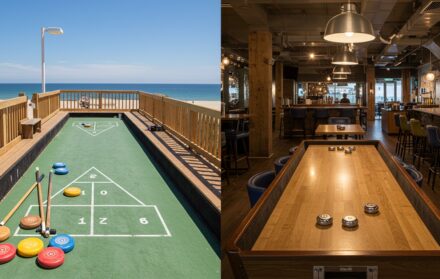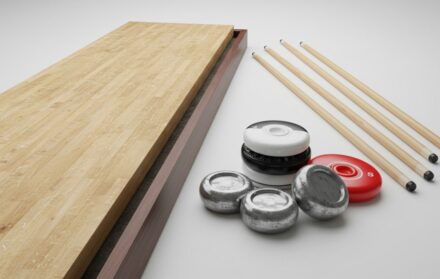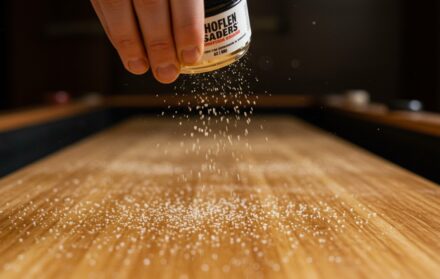
What Are the Best Shuffleboard Variations to Play?
Shuffleboard has always been a game of skill, touch, and social fun. Whether played on a polished table in a lively pub, on the deck of a cruise ship, or in a home games room, its appeal lies in its simplicity. You slide a puck or disc, aim for the scoring zones, and try to outthink your opponent. Yet one of the secrets to shuffleboard’s longevity is how adaptable it is. Over the years, players have invented dozens of variations — some designed to test precision, others to create faster games, and many just for fun at parties.
Trying new shuffleboard variations keeps the game fresh and engaging. For beginners, it provides accessible formats that are less intimidating than traditional scoring. For experienced players, it introduces strategic twists that make the game more challenging. For pubs and clubs, offering different formats encourages regulars to come back, eager to try something new.
This guide explores the best shuffleboard variations to play, explaining how each one works, what makes it fun, and where it fits best — whether at home, in a pub, or on a cruise ship deck.
Best Shuffleboard Variations for Beginners
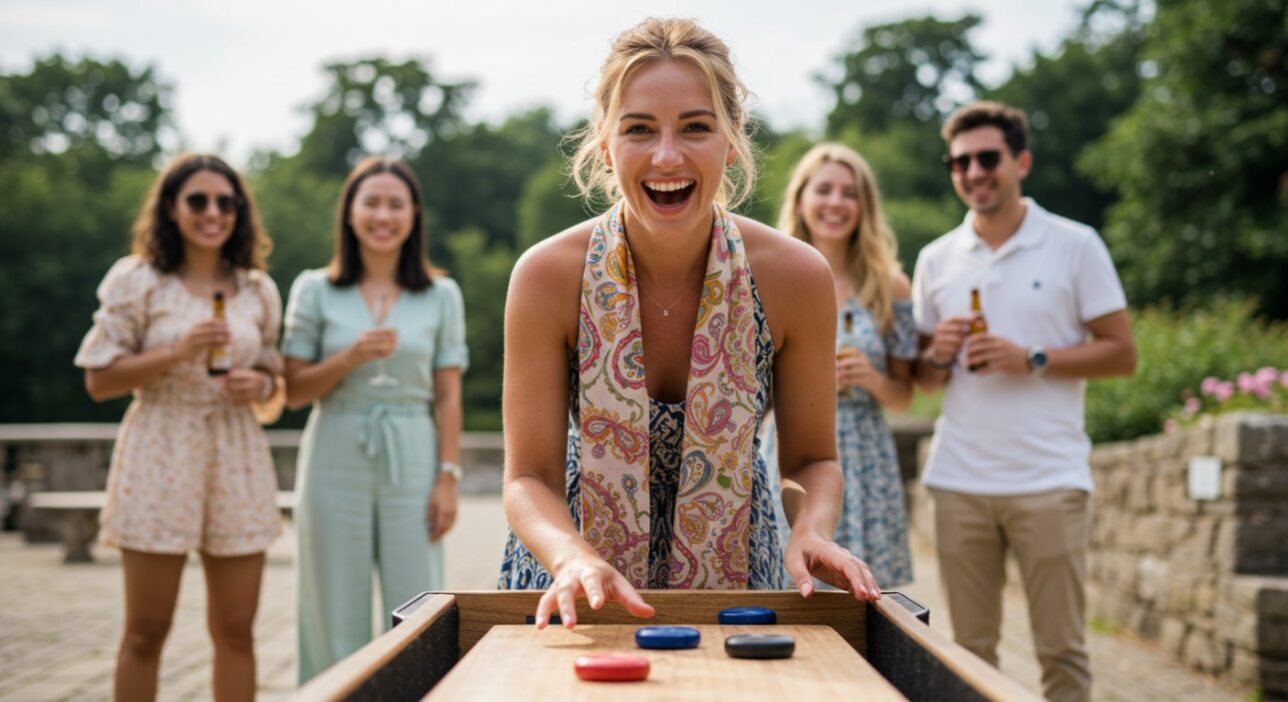
1. Classic Table Shuffleboard (Standard Rules)
How to play:
Classic table shuffleboard is the foundation of every other variation and remains the version most people encounter first. Each player takes four pucks, typically coloured red or blue to distinguish sides. The table is waxed before play, creating the smooth, low-friction surface that makes the game addictive. Players take turns sliding their pucks from one end to the other, aiming to land them in the scoring zones while keeping them on the board.
A typical match starts cautiously, with players experimenting with the speed and touch needed. Soon, the strategy emerges: block opponents, knock their pucks away, and position your own securely. The game rewards finesse more than brute force. Overshooting the table results in wasted effort, while under-shooting leaves your puck vulnerable.
Scoring:
The scoring system is simple but layered with tension. At the far end of the table are three scoring bands: 1, 2, and 3 points, plus the ultimate prize — a “hanger,” where your puck rests on the very edge, partly overhanging, worth 4 points. After each round, only one player scores: the one whose puck is closest to the far end. They count every one of their pucks that sits ahead of their opponent’s best effort.
Imagine one player has pucks in the 2 and 3 zones, while the other has one in the 3 zone but not as far forward. Only the leading 3 and the 2 would count, giving a total of 5 points for the round. This scoring system creates constant swings in momentum and forces players to think not just about where they score, but also about denying their opponent the chance.
Why it’s fun:
Classic shuffleboard is easy to learn but endlessly challenging to master. Beginners can understand the basics in minutes, yet experienced players spend years refining their control and tactical play. The tension of a single shot deciding the round keeps both players and spectators hooked.
Ideal for:
Absolute beginners, casual pub nights, or anyone wanting the purest shuffleboard experience. It’s also the gateway variation — once players know the standard rules, they can easily branch out into the more creative versions described later.
2. Target Shuffleboard
Setup:
Target Shuffleboard is one of the easiest ways to freshen up a game without buying extra equipment. Instead of relying on the traditional scoring zones etched into the table or painted on the court, you create custom targets along the surface. Coloured painter’s tape, sticky notes, or chalk markings (for outdoor deck shuffleboard) all work perfectly. These targets can be simple broad zones for beginners or intricate patterns for more advanced groups. For example, you might mark a large green circle halfway down the table worth 1 point, a smaller blue square near the end worth 3 points, and a tiny red bullseye at the edge worth 5.
How to play:
The mechanics remain familiar: players take turns sliding their pucks down the table. The twist is that instead of landing in fixed scoring bands, they aim for the custom targets. This transforms the feel of the game, since players must adjust speed and angle depending on where each target lies. Unlike standard shuffleboard, where long, smooth slides dominate, Target Shuffleboard encourages varied shot lengths and more imaginative play.
Scoring:
Points are awarded based on which zone the puck lands in, and you can modify values to suit your audience. For a family night with children, make the central zones worth more so kids feel rewarded for simply hitting the board. For more competitive groups, make the high-value targets small and difficult to reach. You can also add special rules — for instance, double points if two pucks land in the same target or minus points for overshooting all targets.
Why it’s fun:
Target Shuffleboard adds a new dimension of creativity. It transforms a straightforward game into something that can be tailored to different groups and occasions. Kids love the visual element of coloured targets, while advanced players enjoy the challenge of aiming for harder zones. It’s also a fantastic practice drill, since aiming at smaller targets sharpens precision for standard games.
Ideal for:
Families looking for a child-friendly option, pubs wanting to run themed nights, or anyone who wants to improve their control through fun, low-pressure practice.
3. Tap & Draw Shuffleboard

How to play:
Tap & Draw is a shuffleboard variation designed to teach touch and precision. Unlike standard shuffleboard, where players usually aim to slide directly into scoring zones, Tap & Draw changes the objective. The first player slides a puck onto the board and leaves it in position. The second player must then tap that puck forward, advancing it into a scoring zone, but without knocking it off the table. Each round continues in this way, with one player setting up and the other trying to improve the placement.
The challenge is subtle but demanding. Too much power, and the tapped puck slides off the edge, scoring nothing. Too little, and it remains outside a scoring zone. The tap must be measured perfectly, applying just enough force to advance the puck but not so much that it overshoots.
Scoring:
You can score Tap & Draw in several ways. The simplest method is to use standard shuffleboard scoring zones, awarding points for where the puck ends up after being tapped. Another option is to assign bonus points for particularly tricky plays, such as moving a puck from the neutral area into the 3-point zone in one controlled tap. Some groups even adopt a penalty rule — if you knock a puck completely off the table, you lose a point, encouraging careful play.
Why it’s fun:
Tap & Draw adds suspense to every shot. Standard shuffleboard can sometimes favour forceful clears and aggressive play, but this variation rewards finesse. It encourages players to practise soft touches, making it a brilliant training exercise as well as a fun game in its own right. Beginners learn control quickly, while experienced players can challenge themselves to execute delicate, high-risk moves. It’s also engaging for spectators, as everyone leans in to see if a perfectly aimed tap will succeed or fail.
Ideal for:
Tap & Draw is especially good for beginners who tend to overshoot and need to refine their sense of distance. It’s also a favourite among groups looking for practice-based mini-games or friendly competitions that highlight skill over power.
4. Knock-Off Shuffleboard
How to play:
Knock-Off Shuffleboard shifts the focus of the game from scoring zones to direct confrontation. Instead of carefully placing your pucks to earn points, the goal is to disrupt your opponent’s progress by knocking their pucks off the board or out of scoring zones. Players still alternate turns sliding pucks down the table, but the emphasis is now on targeting and clearing rather than simply aiming for high-value areas.
This variation typically starts with one player sliding a puck into a scoring zone. Instead of responding with a shot of their own, the next player may aim directly at that puck, sending it off the board. The round quickly becomes a back-and-forth of aggressive clears and clever defensive plays. Success requires not only accuracy but also an understanding of angles and speed — hitting a puck too hard may remove it, but it could also send your own puck flying off as well.
Scoring:
Knock-Off Shuffleboard can be scored in two different ways. In the purest form, points are only awarded if a puck remains in play at the end of the round. Because players are constantly clearing each other’s pucks, many rounds end with very low or even no scores at all. Alternatively, you can use the standard scoring system but place added value on successful knock-offs, such as awarding bonus points for removing an opponent’s puck from the highest zone.
Why it’s fun:
This variation is a favourite for competitive groups because it completely changes the rhythm of the game. Instead of slow, calculated placement, matches become tense and aggressive, with each shot threatening to undo your opponent’s hard work. It sharpens defensive skills, as players must anticipate where opponents will aim next, and it adds a layer of psychological warfare — the satisfaction of watching your opponent’s perfect shot disappear off the board never gets old.
Ideal for:
Knock-Off Shuffleboard is best for training sessions where players want to develop their defensive instincts and for groups who enjoy a more cutthroat, high-energy style of play. Pubs and clubs can also use it as a variation to spice up league nights, keeping regulars engaged with a fresh challenge.
5. Horse Collar Shuffleboard
How to play:
Horse Collar Shuffleboard is widely regarded as one of the most challenging and rewarding shuffleboard variations. Unlike standard shuffleboard, where every scoring band counts, Horse Collar narrows the focus. Players are only allowed to score by landing in the 3-point zone or achieving the coveted hanger, which is worth 4 points. Pucks that land in the 1- or 2-point zones are ignored completely.
This restriction forces players to go for precision shots every time. The game typically starts with players sliding cautiously, trying to secure the 3-point zone. From there, the strategy shifts to either protecting that puck with clever blocks or attempting to dislodge an opponent’s well-placed piece. The hanger — where a puck overhangs the end of the board without falling — becomes the ultimate prize, since it offers the highest point value but demands flawless touch.
Scoring:
The target score in Horse Collar Shuffleboard is usually 51 points, and because only 3s and 4s count, it often takes longer to complete a game compared to standard formats. This longer duration increases the tension, as a single round can dramatically shift the score. For example, a player trailing at 30 could suddenly leap ahead with two hangers in a single round.
Some groups use slight variations to keep the pace brisk, such as lowering the winning score to 31 or awarding bonus points for multiple hangers in a row. Regardless of house rules, the emphasis is always on accuracy and composure under pressure.
Why it’s fun:
Horse Collar appeals to competitive players because it strips the game down to its most demanding elements. There is no room for “safe” 1-point plays or cautious 2-point placements — every shot must be bold and accurate. The game highlights skill differences quickly, making it a favourite in tournaments and league play. Spectators also enjoy it, since the high-value zones mean that drama builds quickly and swings in momentum are common.
Ideal for:
Advanced players who want to push their limits, pubs and clubs running high-level competitions, and serious enthusiasts who see shuffleboard as more than just a casual pastime.
6. Crazy Eight (Exact Score Variants)
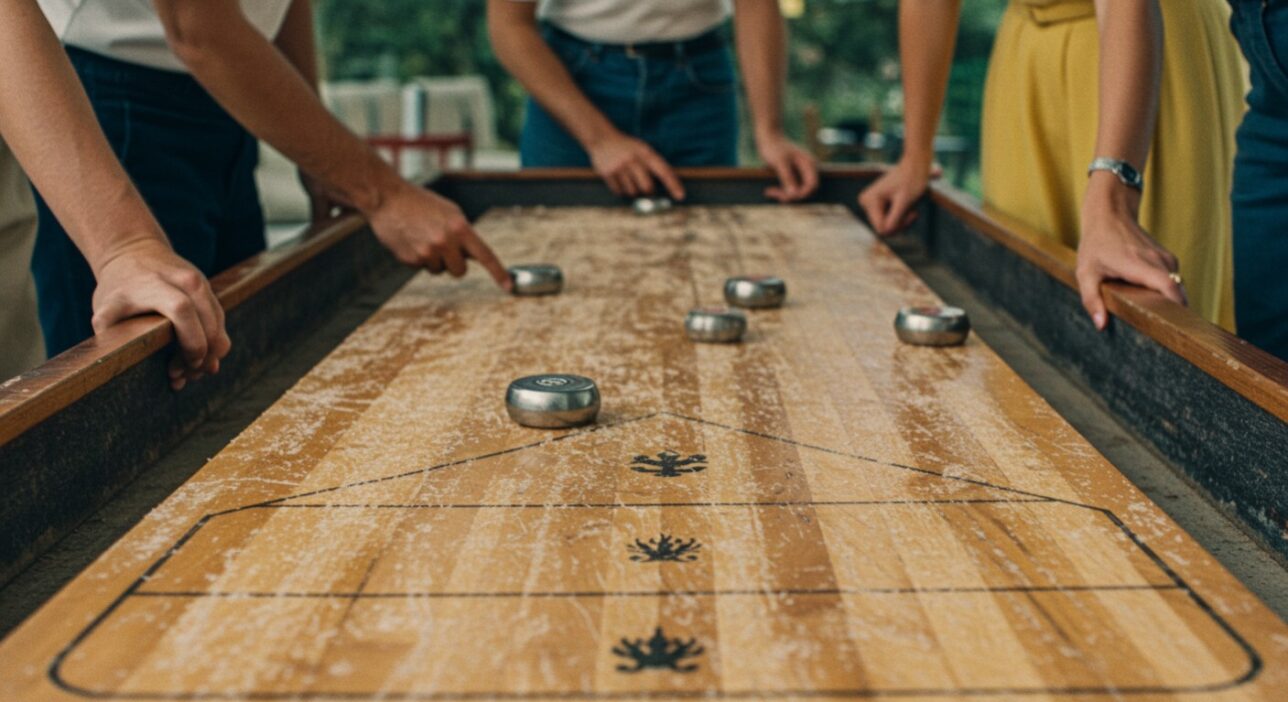
How to play:
Crazy Eight Shuffleboard is a clever twist on the classic game that forces players to think more strategically about every shot. The key rule is simple but unforgiving: each player must finish the round with a score that adds up to exactly a predetermined number — most commonly eight points, though some groups use other targets such as 11 or 15.
Players take turns sliding pucks as usual, but instead of always aiming for the highest-value zone, they must carefully plan their moves to avoid overshooting the target. For example, if a player has already landed two pucks in the 3-point zone (worth 6 points total), their final shots must aim for the 1-point or 2-point zones to reach exactly eight. Landing in another 3-point zone would put them at 9, which disqualifies their score for that round.
This means that Crazy Eight is as much about restraint as it is about precision. Sometimes the smartest play is to deliberately aim for a lower zone or even knock one of your own pucks out of scoring position to stay on track.
Scoring:
At the end of the round, only players who finish with the exact target score earn points toward the overall match total. If no one hits the target, the round is void, and play continues. This creates constant tension, as players know that a single miscalculation can wipe out their efforts.
To make things even more exciting, some variations introduce bonus rules. For instance, scoring exactly eight with only two pucks instead of four might double your round total. Others add a penalty system, subtracting points if you overshoot the target score.
Why it’s fun:
Crazy Eight keeps players on their toes. Unlike traditional shuffleboard, where high-value zones are always desirable, this variation forces you to adapt, calculate, and sometimes make counterintuitive plays. It introduces a mathematical layer to the game, requiring players to think not only about accuracy but also about arithmetic. The suspense of watching someone try to land the final “make or break” shot to reach eight creates brilliant drama for both players and spectators.
Ideal for:
Shuffleboard clubs looking for quirky formats, pub nights where regular players want something fresh, and groups that enjoy games combining skill with puzzle-like challenges.
7. Call-Your-Shot Shuffleboard
How to play:
Call-Your-Shot Shuffleboard transforms a standard match into a test of both confidence and accuracy. Before sliding a puck, the player must declare their intended move. This could be aiming for a specific scoring zone, attempting a hanger, or knocking an opponent’s puck off the table. Once declared, the shot must match the claim to count. If the puck lands elsewhere or the attempt fails, the shot is void and the puck is removed from play.
This adds an extra mental layer to the game. Instead of simply reacting to the board state, players are committing to a plan out loud. The room becomes invested in whether they can pull it off. Even a simple declaration like “I’ll land in the 2 zone” carries pressure, because everyone is watching closely to see if the puck obeys.
Scoring:
When successful, the shot is scored as normal under standard shuffleboard rules. Some groups like to add bonus points for ambitious calls — such as doubling the value of a hanger if it was declared beforehand. Conversely, missing a called shot may incur a penalty in some versions, like losing a point, to further raise the stakes.
This flexibility allows organisers to adjust the difficulty and intensity of the game. Casual groups may keep it light, rewarding only successful shots without harsh penalties, while competitive circles might enforce stricter scoring to keep players sharp.
Why it’s fun:
Call-Your-Shot combines skill with theatre. It punishes indecision and rewards boldness, making it as entertaining to watch as it is to play. The drama builds when someone declares a risky knock-off or claims they’ll nail a hanger — and the tension in the room is palpable as the puck slides toward its destination. Spectators enjoy the suspense, and players enjoy the satisfaction of proving themselves under pressure.
Ideal for:
This variation suits confident players, competitive matches where mental toughness is tested, and pub nights where banter and spectacle are part of the fun. It’s also a great choice for tournaments looking for a “highlight reel” format, since called shots often create the most memorable moments.
8. Bowling Shuffleboard
Setup:
Bowling Shuffleboard combines two classic games into one irresistible variation. To play, set up a triangular formation of ten miniature pins (or markers) at one end of the table, mimicking a bowling lane. Commercial shuffleboard bowling kits are available, but you can improvise with small objects such as bottle caps, toy pins, or even coins as stand-ins. The idea is to create a rack that can be “knocked down” by sliding shuffleboard pucks into them.
How to play:
Players take turns sliding pucks down the table as though they are bowling balls. Each round represents a bowling frame, where players get two shots to clear as many pins as possible. A strike is scored when all ten pins fall with the first puck; a spare is when the remaining pins are cleared on the second attempt. Standard ten-pin scoring applies, with bonuses awarded for strikes and spares.
Scoring:
If you want to simplify, especially for family settings, you can use a direct point system: one point per pin knocked down. For more authentic play, stick to full bowling scoring, which makes games more strategic and competitive. Some groups even add house rules such as double points if you manage to “bank shot” a puck into the pins off the side rail.
Why it’s fun:
Bowling Shuffleboard is a hit because it blends the familiar excitement of bowling with the unique dynamics of shuffleboard. It’s accessible to children, engaging for adults, and works brilliantly in pubs, where groups can cheer as loudly as they would at a bowling alley. The quick rounds and visible spectacle of falling pins keep everyone involved, whether they’re playing or watching.
Ideal for:
Home gatherings, birthday parties, pubs hosting themed nights, or any event where you want to encourage a fun, light-hearted atmosphere.
9. Shuffle-Golf

Setup:
Shuffle-Golf borrows from golf’s leisurely pace and strategic play. To prepare, mark out several “holes” along the shuffleboard table. These can be simple circles of tape or chalked areas with assigned “par” values, just like golf holes. A full course might include five or nine holes depending on how much time you have.
How to play:
Players take turns sliding pucks toward the first hole, aiming to land inside it in as few attempts as possible. Each puck represents a stroke, and players continue until their puck rests inside the target zone. Once all players complete a hole, they move to the next.
Scoring:
Scoring mirrors golf: the player with the lowest total strokes across all holes wins. For extra challenge, add hazards — perhaps declare the gutter as “out of bounds” or place a block puck halfway down the table to mimic a bunker.
Why it’s fun:
Shuffle-Golf changes the rhythm of shuffleboard. Instead of each round resetting, players work through a “course,” building tension as scores accumulate. It’s strategic rather than aggressive, appealing to players who enjoy slower-paced, thoughtful games. It also introduces endless customisation, since organisers can design creative courses with quirky rules.
Ideal for:
Groups that enjoy golf, families looking for a relaxed but competitive activity, or pubs wanting to run novelty tournaments that feel different from standard shuffleboard nights.
10. Speed Shuffleboard
How to play:
Speed Shuffleboard injects energy into the game by imposing a time limit on every shot. Instead of carefully lining up and taking as long as you want, players must release their puck within 10 to 15 seconds of their turn beginning. A referee or timer enforces the countdown, and failing to shoot in time either voids the puck or incurs a penalty.
Scoring:
The game still uses standard scoring zones, but the pace of play is radically different. Matches move much faster, and hesitation can cost valuable points. Some groups like to run this as a “sprint” format, with first-to-11 matches to keep turnover high.
Why it’s fun:
Speed Shuffleboard eliminates long pauses and forces players to rely on instinct. This keeps the energy high and makes it especially entertaining for spectators. In a pub or club setting, it ensures games don’t drag on, allowing more people to participate in the same evening. The time pressure also adds a layer of tension — even skilled players can falter when the clock is ticking.
Ideal for:
Busy pub nights, tournaments with limited time, or casual gatherings where energy and laughter are more important than precision strategy.
House Rules and Modifiers
-
Handicaps: give beginners bonus points or allow last-shot advantages.
-
Shot restrictions: only backhand shots, or no knock-offs until the final puck.
-
Scoring multipliers: double points if two pucks touch; minus points for gutters.
-
Wax speed challenges: rotate between slow, medium, and fast wax each round.
House rules keep shuffleboard dynamic and tailored to your group.
Conclusion: The Best Shuffleboard Variation Is the One You’ll Actually Play

There is no single “best” shuffleboard variation — the right choice depends on your players, your venue, and your goals. Classic table shuffleboard is ideal for beginners, competitive formats like Horse Collar and Knock-Off challenge skilled players, while party games like Bowling Shuffleboard or Speed Shuffleboard are perfect for pubs and family nights.
The beauty of shuffleboard is its adaptability. Rotate between a few variations, invent your own house rules, and keep the game fresh. With so many options, shuffleboard can evolve with every gathering, ensuring it never loses its appeal.


